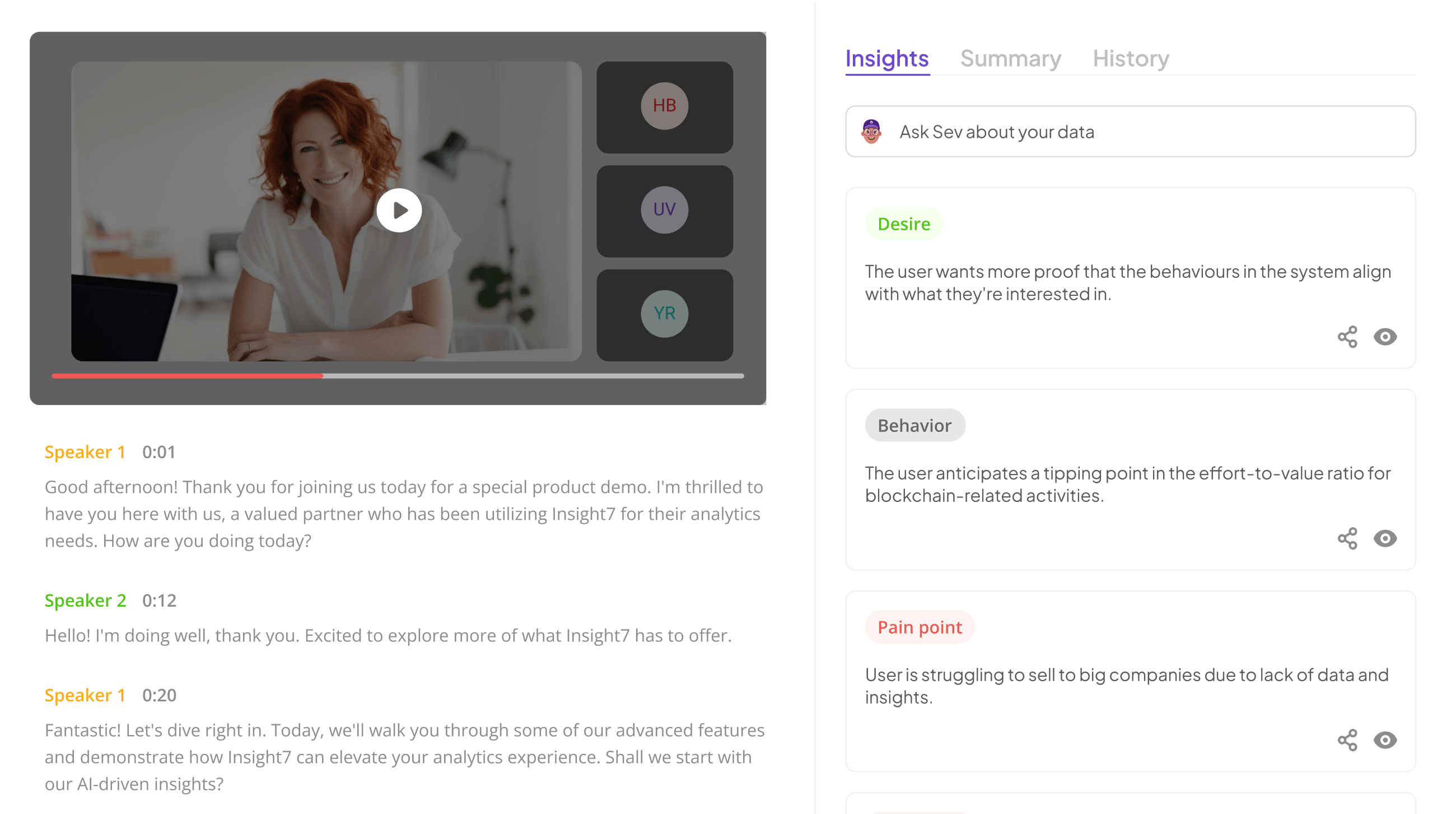Decoding Consumer Decisions: The Psychology Behind What Makes People Buy
-
Bella Williams
- 10 min read
Consumer buying psychology delves into the intricate ways our thoughts and emotions influence purchasing behaviors. Imagine standing in a store, surrounded by countless products, and feeling overwhelmed by choices. This scenario captures the essence of consumer psychology: understanding how emotional triggers, social influences, and personal motivations affect decisions. Grasping this complex framework is essential for businesses aiming to connect with their customers effectively.
By studying consumer buying psychology, businesses can gain valuable insights into what drives their audience. This understanding enables them to tailor marketing strategies that resonate deeply with potential buyers. As we explore the foundations of these psychological principles, we will uncover key factors that guide consumers from problem recognition to post-purchase evaluation.
Analyze & Evaluate Calls. At Scale.

Understanding the Consumer Buying Psychology
Consumer buying psychology delves into the mental and emotional processes that shape purchasing behaviors. Understanding this psychology is essential for businesses aiming to connect effectively with customers. It encompasses how emotions, subconscious influences, and social factors drive buyer decisions, illustrating that choices are not always rational.
Several key factors have a profound impact on consumer buying psychology. First, emotional triggers play a pivotal role; people often buy based on feelings rather than logic. Next, social proof, like reviews and testimonials, significantly influences purchasing choices by creating a sense of trust and validation. Additionally, understanding the consumer journey, from recognizing a need to post-purchase evaluation, is crucial for businesses. By analyzing these elements carefully, companies can craft marketing strategies that resonate deeply with their target audience and ultimately drive sales.
Emotional Triggers in Consumer Buying Psychology
Emotional triggers play a crucial role in consumer buying psychology, significantly influencing how individuals make purchase decisions. When consumers engage with a brand, emotional responses often outweigh logical reasoning. For instance, feelings like happiness, nostalgia, or even fear can drive a person to choose one product over another. This emotional connection fosters loyalty and enhances brand preference.
Understanding these emotional triggers is vital for marketers seeking to connect authentically with their audience. Common emotional triggers include the desire for security, the need for belonging, and the aspiration for status. By tapping into these emotions, brands can craft compelling narratives that resonate deeply with consumers. When marketing messages align with emotional triggers, the likelihood of conversion increases, highlighting the importance of emotional awareness in consumer buying psychology.
The Role of Social Proof in Consumer Buying Psychology
In the realm of consumer buying psychology, social proof plays a crucial role in shaping purchasing decisions. When potential customers observe others engaging with a product or service, their perception often shifts, leading them to mimic that behavior. This phenomenon is closely tied to the psychological concept of conformity, where individuals align their actions with those of a group to feel accepted and validated.
Social proof manifests in various forms, such as customer reviews, testimonials, and social media endorsements. Firstly, positive reviews serve as a reassurance for customers, alleviating fears related to quality and reliability. Secondly, testimonials provide personal stories that resonate on an emotional level, compelling buyers to relate to the experiences of others. Lastly, endorsements from influencers or experts can significantly sway consumer opinions, as they lend credibility and authority to a product. Understanding these facets of social proof can empower businesses to harness them effectively, ultimately influencing consumer behavior and enhancing sales outcomes.
Extract insights from interviews, calls, surveys and reviews for insights in minutes
Decoding the Decision-Making Process
Every consumer decision begins with problem recognition, the first step in the decision-making process. It occurs when individuals identify a need or want that drives their desire to buy. This realization sparks a series of thoughts and emotions tied to their specific wants. Understanding this initial phase is vital as it sets the course for the entire decision-making journey.
After problem recognition, consumers engage in an information search, seeking solutions to satisfy their identified need. At this stage, they gather data from various sources—friends, online reviews, or comparison websites—to explore options. The evaluation of alternatives follows, where consumers weigh the pros and cons of each potential choice. This crucial step influences both their final purchase decision and overall satisfaction. Lastly, post-purchase evaluation assesses whether the product met their expectations. Consumers analyze their experience, which can impact their future buying behavior.
By decoding this decision-making process, businesses can better understand consumer buying psychology and tailor their approaches accordingly, ensuring they meet the needs of prospective customers.
Step 1: Problem Recognition
Problem recognition serves as the foundation of consumer buying psychology, marking the moment when a consumer identifies a need or desire. This crucial first step shapes their entire decision-making journey. When a customer realizes a gap between their current state and their desired outcome, they begin to seek solutions. This conscious acknowledgment of a problem sparks curiosity and evaluations of potential remedies.
Understanding problem recognition involves analyzing various triggers. Factors such as personal circumstances, marketing influences, or societal expectations can prompt this awareness. The emotional response to a specific need is a significant motivator for consumers, often driving them to explore options actively. Recognizing these stimuli helps businesses tailor their strategies effectively. By addressing customers' problems with relevant solutions, brands can foster loyalty and boost sales. Thus, understanding this key phase is essential in navigating the intricate landscape of consumer decisions.
Step 2: Information Search
In the information search stage, consumers actively gather data to make informed purchasing decisions. This phase is crucial as it bridges the gap between recognizing a need and evaluating available options. During this stage, consumers typically seek information from various sources, such as online reviews, product specifications, and recommendations from friends or family. Understanding consumer buying psychology reveals how consumers prioritize certain information sources over others, often placing trust in peer opinions or expert analyses.
The effectiveness of the information search relies on the consumer's motivation and the availability of resources. Factors like brand reputation and prior experiences significantly influence what information consumers deem credible. Additionally, shoppers may utilize tools such as comparison websites or seek out market reports to ensure they make the best choices. By understanding these dynamics, businesses can better tailor their messaging, ensuring that the information provided aligns with consumer expectations and helps facilitate their purchasing journey.
Step 3: Evaluation of Alternatives
In the Evaluation of Alternatives step, consumers critically assess their options before making a purchase decision. This phase highlights the importance of understanding consumer buying psychology, as it influences how individuals compare various products. Consumers weigh attributes such as price, quality, and brand reputation, seeking the best value that meets their needs. Emotional responses often factor into these evaluations, leading consumers to favor products that resonate with their preferences or aspirations.
To navigate this step effectively, consumers typically follow several key processes. First, they identify their selection criteria based on personal needs and values. Next, they research the available options, gathering information from various sources, including friends, family, and online reviews. Finally, consumers compare the alternatives against their criteria, which may lead them to favor one product over another. This thoughtful evaluation process ultimately shapes their final choice, demonstrating the intricate interplay between individual preferences and broader psychological factors in consumer behavior.
Step 4: Purchase Decision
In the purchase decision stage, consumers are faced with the final stretch of their buying journey. At this point, they have identified a problem, gathered information, and evaluated alternatives. Their choice hinges on an interplay of factors, including emotional resonance and perceived value. Understanding consumer buying psychology becomes vital here, as it reveals the underlying motivations that influence purchasing behavior.
Consumers weigh the benefits against uncertainties, such as pricing and brand reputation. Brands that effectively communicate trust and value can tip the scales in their favor. Additionally, instinctual triggers like urgency or exclusive offers often play a crucial role. As a result, savvy marketers must craft compelling messages that align with consumer desires, ensuring that decision-makers feel confident in their choice. Thus, this stage represents not just a final decision but a culmination of psychological cues.
Step 5: Post-Purchase Evaluation
After making a purchase, consumers engage in a crucial phase known as post-purchase evaluation. This step involves reflecting on their decision and assessing whether it met their expectations. Often, consumers evaluate the product's quality, its performance, and their emotional satisfaction. Positive reinforcement through a favorable experience can enhance brand loyalty, while negative feelings may prompt them to reconsider future purchases.
During this evaluation, factors such as confirmation bias and cognitive dissonance play significant roles. Consumers tend to seek out information that supports their buying decisions while dismissing contradictory evidence. Understanding this aspect of consumer buying psychology is vital for brands aiming to foster lasting relationships with their customers. By addressing any potential dissatisfaction swiftly and effectively, companies can turn a negative post-purchase experience into an opportunity for growth and improvement.
Conclusion: Harnessing Consumer Buying Psychology for Business Success
Understanding consumer buying psychology offers invaluable insights for businesses seeking to connect with their customers effectively. By recognizing the emotional triggers and social influences that drive purchasing decisions, companies can tailor their marketing strategies to resonate with their target audience. This alignment allows businesses to not only attract potential customers but also convert interest into actual sales.
Utilizing consumer buying psychology creates a competitive advantage in today’s market. As businesses implement these insights, they should continuously assess and refine their approaches based on consumer feedback and behaviors. Ultimately, those who harness these psychological principles will thrive, fostering stronger relationships with customers and ensuring long-term business success.







